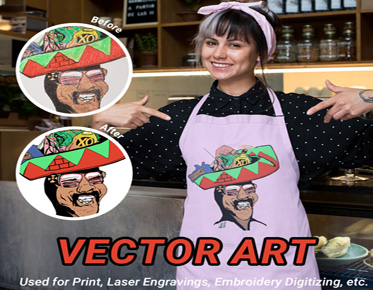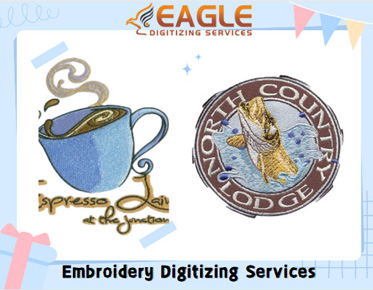Decoding Ethical Dilemmas in Vector Art
Welcome to a deep dive into the ethics of digitized vector graphics development. In a world where digital design is omnipresent, understanding the ethical
implications of our work is more important than ever.
Importance of Addressing Ethical
Issues in Digital Design
Addressing ethical issues in digital design isn't just a
nice-to-have—it's a must. Ethical design practices ensure that our creations
are fair, respectful, and responsible. They safeguard the integrity of our work
and the well-being of our audience.
Overview of What to Expect in
This Guide
In this guide, we’ll explore various ethical dimensions of vector graphics development. From responsible use of stock graphics to ensuring diversity and inclusion, we'll cover it all. We’ll also touch on environmental impacts, privacy concerns, and the importance of transparency and honesty in design processes.
Responsible
Use of Stock Graphics and Vector Art
Understanding the Ethical Use of
Stock Graphics
Stock graphics are a designer’s best friend, offering a treasure trove
of resources. But with great power comes great responsibility. Ethically using
stock graphics means respecting the terms of use and licensing agreements.
Importance of Properly Licensing
and Crediting Vector Art
Proper licensing is crucial. It ensures that the original creators are
compensated for their work. Always check the license and give credit where it’s
due. This not only respects the creator’s rights but also builds a culture of
integrity within the design community.
Risks of Unauthorized Use and Copyright
Infringement
Unauthorized use of graphics can lead to legal troubles and tarnish your reputation. Copyright infringement is a serious issue that can result in fines, lawsuits, and the loss of trust. Always ensure you have the right to use any graphic in your work.
Avoiding
Cultural Appropriation in Graphic Design
Definition of Cultural
Appropriation in Design
Cultural appropriation in design refers to the inappropriate adoption
of elements from one culture by another, often without permission. This can be
disrespectful and perpetuate stereotypes.
Examples of Cultural
Appropriation in Vector Graphics
Using traditional symbols or motifs from a culture without
understanding their significance is a common example. Such misuse can
trivialize and misrepresent cultural identities.
Tips for Creating Culturally
Sensitive Artwork
Creating culturally sensitive artwork involves research and respect. Engage with members of the culture, seek permission, and ensure accurate representation. This fosters inclusivity and respects cultural heritage.
Representation
and Diversity in Vector Graphics
Importance of Representation in
Design
Representation matters. It ensures that all individuals see themselves
reflected in the media and designs they interact with. This fosters inclusivity
and empowers marginalized groups.
Ensuring Diversity and Inclusion
in Vector Art
Diversity in vector art means using a variety of skin tones, body
types, and cultural symbols. It involves creating inclusive designs that
reflect the real world’s diversity.
Challenges and Opportunities in Representing
Diverse Identities
While representing diverse identities can be challenging, it’s also an opportunity to enrich your work. It requires sensitivity and awareness but leads to more meaningful and impactful designs.
Environmental
Impact of Digital Design Practices
Understanding the Environmental Footprint
of Digital Design
Digital design might seem eco-friendly, but it has an environmental
footprint. The energy consumed by powerful computers and servers contributes to
carbon emissions.
Sustainable Practices in Vector
Graphics Development
Sustainable design practices include optimizing file sizes to reduce
energy consumption and using eco-friendly software and hardware. Reducing our
environmental effects starts with small steps.
Minimizing Waste and Energy
Consumption in Design Processes
Streamlining design processes to minimize waste and energy consumption is crucial. This can involve using efficient tools, recycling old devices, and advocating for sustainable practices in the industry.
Ethical
Considerations in Advertising and Marketing Graphics
Ethics of Persuasion and Manipulation
in Graphic Design
Graphic design in advertising walks a fine line between persuasion and
manipulation. Ethical design avoids exploiting emotions or misleading
consumers.
Avoiding Misleading and
Deceptive Advertising Practices
Clear, honest, and transparent communication is key. Avoid deceptive
practices like exaggerating benefits or hiding crucial information. Ethical
advertising builds trust and long-term customer relationships.
Balancing Ethical Considerations
with Business Objectives
Balancing ethics with business objectives can be challenging. However, prioritizing ethical practices can lead to sustainable success and a loyal customer base.
Privacy
and Data Protection in Digital Design
Risks of Privacy Violations in
Digital Design
Privacy violations can occur if personal data is mishandled or
misused. This is a significant ethical concern in today’s data-driven world.
Ethical Handling of User Data in
Vector Graphics Development
Ethical data handling involves transparency about data use, obtaining
informed consent, and ensuring data security. Respect users’ privacy to build
trust and protect their rights.
Compliance with Data Protection
Regulations (GDPR, CCPA, etc.)
Regulations such as GDPR and CCPA must be followed without exception. These laws protect user data and privacy, and adhering to them is a fundamental aspect of ethical design.
Accessibility
in Vector Graphics Development
Importance of Accessibility in
Digital Design
Accessibility ensures that digital designs are usable by everyone,
including people with disabilities. It is more than a legal duty; it is also a
moral imperative.
Designing Vector Graphics with
Accessibility in Mind
Designing for accessibility involves considering color contrast, text
readability, and navigability. It ensures that everyone, regardless of ability,
can interact with your designs.
Ensuring Equal Access to
Information and Services
Equal access means creating designs that work for everyone. This includes using accessible formats and providing alternative text for images and graphics.
Combatting
Misinformation and Fake News with Graphic Design
Role of Visual Communication in
Misinformation
Visuals are powerful tools for communication, but they can also be
used to spread misinformation. Designers have a responsibility to ensure their
work is accurate and truthful.
Ethical Responsibility of
Designers in Combatting Fake News
Designers should verify the information they present and avoid
creating misleading graphics. This promotes trust and credibility in the
information age.
Promoting Critical Thinking and
Media Literacy Through Design
Design can encourage critical thinking and media literacy by presenting information clearly and accurately. Educating the public through design is a powerful way to combat misinformation.
Fair
Labor Practices in Vector Graphics Development
Ethical Considerations in
Outsourcing Design Work
Outsourcing can lead to ethical issues if not managed responsibly.
Ensure fair labor practices and compensation when working with external
designers.
Ensuring Fair Compensation and
Working Conditions for Designers
Fair pay and good working conditions are essential. Ethical practices
include providing adequate compensation and a safe, respectful work
environment.
Supporting Ethical Companies and
Practices in the Design Industry
Support companies and practices that prioritize ethics. This promotes a culture of fairness and respect within the industry.
Social
Responsibility in Vector Graphics Development
Using Design to Advocate for
Social Causes and Justice
Design has the power to advocate for social causes and justice. Use
your skills to highlight important issues and drive positive change.
Addressing Societal Issues
Through Visual Communication
Visual communication can raise awareness and prompt action on societal
issues. Design with a purpose to make a meaningful impact.
Examples of Socially Responsible
Design Campaigns
Look to examples of successful design campaigns that have advocated for social causes. These inspire and demonstrate the power of ethical design.
Transparency
and Honesty in Design Processes
Importance of Transparency in
Design Practices
Transparency builds trust. Be open about your design processes,
decisions, and any challenges face.
Ethical Communication with
Clients and Stakeholders
Communicate honestly with clients and stakeholders. Clear and ethical
communication fosters strong, trusting relationships.
Building Trust Through Openness
and Integrity
Openness and integrity are the cornerstones of ethical design. They build trust and credibility, ensuring long-term success.
Education
and Awareness in Ethical Design Practices
Promoting Ethical Design
Education in Schools and Universities
Integrate ethical design education into curricula. Future designers
should be equipped with the knowledge to make ethical decisions.
Raising Awareness Among
Designers and Industry Professionals
Raise awareness about ethical issues within the industry. Continuous
learning and discussion promote better practices.
Encouraging Continuous Learning
and Improvement in Ethical Practices
Ethical design is an ongoing process. Encourage continuous learning and improvement to stay ahead of emerging ethical challenges.
Ethical
Leadership and Accountability in Design Agencies
Role of Design Agency Leaders in
Promoting Ethical Practices
Leaders set the tone for ethical practices within design agencies.
They should model ethical behavior and establish clear guidelines.
Establishing Ethical Guidelines
and Codes of Conduct
Create and enforce ethical guidelines and codes of conduct. This
provides a framework for ethical decision-making.
Holding Individuals and
Organizations Accountable for Ethical Lapses
Accountability is crucial. Ensure that individuals and organizations are held responsible for ethical lapses.
Collaboration
and Community Engagement in Ethical Design
Importance of Collaboration in
Addressing Ethical Issues
Collaboration helps address complex ethical issues. Working together
leads to more comprehensive and effective solutions.
Engaging with Design Communities
and Advocacy Groups
Engage with design communities and advocacy groups. These networks
provide support, resources, and collective wisdom.
Sharing Best Practices and
Resources for Ethical Design
Share best practices and resources to promote ethical design. This fosters a culture of learning and improvement.
Impact
of Ethical Considerations on Design Quality and Effectiveness
How Ethical Design Practices
Enhance Overall Quality
Ethical design practices improve the quality of work. They ensure that
designs are not only visually appealing but also fair, respectful, and
responsible.
Positive Effects of Ethical
Design on User Experience and Engagement
Ethical design enhances user experience and engagement. Users
appreciate and trust designs that are created with integrity.
Building Trust and Loyalty
Through Ethical Design
Ethical design builds trust and loyalty. When users know that you prioritize ethics, they are more likely to become long-term supporters.
Ethical considerations in vectorizing services development are multifaceted and crucial. They encompass the responsible use of resources, cultural sensitivity, representation, environmental impact, and more.
Prioritize ethical practices in your design work. This ensures that your creations are not only beautiful but also fair and responsible. Ethics will continue to shape the future of design. By adhering to ethical principles, we can create a more just, respectful, and inclusive digital world.



